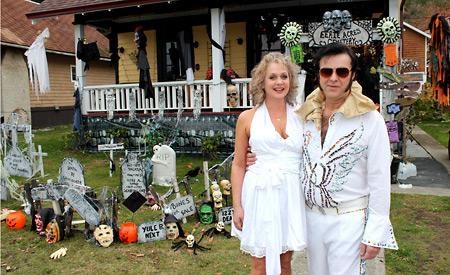Halloween may seem simple enough. Carve a jack-o’-lantern. Dress up in a scary costume. Go around the neighbourhood and ask for candy. Attend a costume party. But Halloween boasts a rich and complex history and has evolved over the years from Celtic and Christian celebration to a blend of street festival, fright night and vast commercial enterprise.
Canadian cultural historian Nicholas Rogers has taken a close look at Halloween in his book, From Pagan Ritual to Party Night. He traces the origins of Halloween to the Celtic festival of Samhain, which means summer’s end. It was celebrated as a harvest festival in Ireland, and to All Saints’ Eve, or as it was called All Hallows Eve. Rogers links contemporary trick-or-treating to the practice of “souling,” which was common before All Saints’ Day or All Souls’ Day in medieval Europe. The poor would wander from house to house asking for soul cakes as a way to pray for souls of those who had yet to be allowed to enter heaven. Later, Rogers connects contemporary trick-or-treating to a custom in Scotland and Ireland of “guising” where children would dress up in costumes to go house to house asking for coins and food.
Halloween was brought to North America with mass immigration of people from Scotland and Ireland in the mid-19th century, though North American almanacs do not mention it as a holiday until the late 19th century. The rise of gothic and horror literature at this time helped popularize fantastical creatures such as Frankenstein’s monster, mad scientists, mummies and vampires. Rogers writes that the first recorded mention in a North American newspaper of children trick-or-treating was from 1911 in Kingston, Ontario. The first jack-o’-lanterns were carved from pumpkins in North America. Previously, carvers would use turnips.
It wasn’t until the early 20th century that the festival evolved into an unofficial, large scale holiday. According to Rogers the first mass-produced children’s costumes for trick-or-treating were available in stores in the 1930s as guising in North America had become popular.
Hollywood helped shape the popular imagination for monsters as it brought Count Dracula and a whole host of monsters from horror literature to the big screen. It wasn’t until the sadism of the 1970s and 1980s horror film genre that Halloween was shaped into a festival of terror.
For Rogers, although much has changed over the years, the holiday, at its core, remains the same. He calls it “a night of inversion” where social norms are flipped and a temporary freedom of expression reigns supreme.
Bill and Evelyn Rice are big on self-expression. They live on Maple Avenue and consistently for the past 10 years they have spent hours upon hours decorating their home inside and out.
“I don’t know why we do, I guess because it’s fun,” said Evelyn. “For Halloween you get to be anything but yourself. You get to pick what you want to be.”
The Rices are having a Halloween party at their home this year so they’ve paid extra close attention to all the details. Plastic skull-lined shelves, fake cobwebs and fake blood splatter are floor to ceiling. Evelyn is building an “autopsy” table complete with a skeleton of bread and bowls for where internal organs should reside. “We do little autopsy bags for the trick-or-treaters,” she said.
“We get over 300 trick-or-treaters here. They pull up in buses out there,” added Bill, pointing to the street.
The Rices are unofficially the leaders of Halloween home decoration on their street in Townsite. “After we start decorating,” said Evelyn, “everyone on Maple gets into it.”
Bill and Evelyn estimate they have put a couple thousand dollars into buying decorations over the years.
“We get a lot of stuff from the dollar store,” said Evelyn, “and we reuse decorations and reinvent stuff.”
She takes items like masks and puts them together with black garbage bags and milk jugs to create the monsters in her garden.
“We buy a lot of it off-season,” said Bill. The neighbourhood helps out as well. Bill said that after one of his neighbours died, he was given the neighbour’s Halloween decorations.
Bill and Evelyn have teenagers in their house. “They’re embarrassed,” said Bill.
“But we all dress up in costumes. I make their costumes,” said Evelyn. “They’re into it when they want to be into it and embarrassed when they’re not.”
Evelyn said she changes costumes frequently on Halloween, but Bill not so much. Bill’s costume is draped over the back of his chair. Sequins and white polyester. He’s Elvis this year. Then Bill shows me the woolly mutton chops that he’s growing on the sides of his face. “They’ll ripen.”
Parties and trick-or-treating aside, Halloween has become a time for the community to come together for good causes. This year Brooks Secondary School students have organized a Halloween for Hunger event and are collecting canned food for the local food bank. And a standing Powell River Halloween tradition has been elementary school haunted houses. This year James Thomson Elementary held its Halloween Carnival on October 26 and Henderson Elementary put on its annual Haunted House.
Dale Lawson, a past member of the Parent Advisory Council (PAC) for Henderson, was project coordinator for the school’s haunted house until last year. Lawson and other members of PAC started hosting the haunted house eight years ago. She said the project was started as a way to raise over $10,000 for sending Henderson students on a field trip to Strathcona Lodge.



